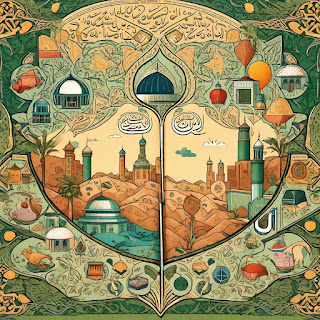What is Ruqyah Shariah? A Simple Guide to Islamic Spiritual Healing
Introduction
In a world full of anxiety, health issues, and invisible harm, many Muslims seek comfort in Ruqyah Shariah — an authentic form of spiritual healing taught and practiced by Prophet Muhammad (peace be upon him). But what exactly is Ruqyah Shariah, and how can it benefit us? This guide aims to explain everything in plain, easy-to-follow terms, so that anyone can understand and apply this powerful Islamic tradition in their daily life.
🌿 Understanding Ruqyah Shariah
Ruqyah Shariah refers to the Islamic practice of spiritual healing by reciting specific verses from the Qur’an and using authentic supplications (du’as) from the Sunnah. The purpose is to seek help and healing directly from Allah — without relying on any prohibited or superstitious methods.
This spiritual remedy is used to treat:
-
The evil eye (al-‘ayn)
-
Possession by jinn
-
Black magic (sihr)
-
Physical and psychological issues
-
Protection from harm and negative energy
🔑 What Makes Ruqyah Shariah Unique?
Here are the core principles that define authentic Ruqyah:
-
It depends solely on Allah’s words (the Qur’an) and His names and attributes.
-
It is completely free of shirk, meaning no involvement of other gods, spirits, or energies.
-
No talismans, amulets, or rituals are involved — only what is taught in Islam.
-
It can be performed by yourself or by someone else you trust, with proper manners and intentions.
-
The practice often includes recitation, du’as, and gentle blowing (nafh) over the body.
📖 Common Qur’anic Verses Used in Ruqyah
These verses have been reported in the Sunnah as effective for spiritual and physical protection:
| Surah / Verse | Purpose |
|---|---|
| Surah Al-Fatihah (1:1–7) | General healing for all types of ailments |
| Ayat al-Kursi (2:255) | Protection from jinn, evil, and harm |
| Al-Baqarah (2:285–286) | Night-time protection, spiritual shield |
| Surah Al-Ikhlas, Al-Falaq, An-Nas | Defense against black magic, envy, evil eye |
| Al-A’raf (7:117–122), Yunus (10:81–82), Taha (20:68–70) | Targeted verses against magic and sorcery |
🤲 Powerful Du’as from the Sunnah
These authentic prayers were used by the Prophet (ﷺ) for protection and healing:
-
“A‘udhu bi kalimaat-illaahi al-taammaati min sharri maa khalaq”
“I seek refuge in the perfect words of Allah from the evil of what He has created.” -
“Bismillah arqeek, min kulli shay’in yu’dheek...”
“In the name of Allah, I recite over you to protect you from everything that harms you...”
These can be recited regularly over oneself, children, or others in need of healing.
🛠️ How to Perform Ruqyah Shariah Step-by-Step
Performing Ruqyah is simple, and with sincerity, anyone can do it:
-
Start with intention (niyyah): Make your intention clear that you are seeking healing from Allah alone.
-
Be in wudu (state of purity): This increases the spiritual impact and follows the Sunnah.
-
Recite the Qur’anic verses and du’as: Do so slowly, clearly, and with full concentration.
-
Blow lightly (nafh): After recitation, gently blow over the body or affected area.
-
Repeat daily: Ruqyah works best with consistency — especially morning, evening, or before sleep.
-
Avoid non-Islamic elements: Do not include anything like charms, taweez, or unverified rituals.
💡 Important Guidelines
Keep these principles in mind to ensure your Ruqyah remains authentic:
-
Use only Qur’an and Sunnah-based recitations.
-
Never call upon jinn, spirits, or any other entity besides Allah.
-
Avoid using amulets, taweez, or symbols from cultural or magical practices.
-
Don’t rely on fake “healers” or magicians who demand payment or use unknown rituals.
-
Trust in Allah’s timing — healing may take time and patience.
🧘♂️ Can You Do Ruqyah on Yourself? Yes!
Self-ruqyah is not only allowed, but it is highly recommended by many scholars. It strengthens your connection with Allah and builds reliance on Him alone.
👉 To do this: Recite the verses over yourself, blow lightly on your hands, and wipe over your body. Do this regularly — especially in the morning, evening, and before sleep.
⚠️ Practices to Avoid (Not Ruqyah Shariah)
Some actions are not part of Ruqyah Shariah and are forbidden in Islam:
-
Consulting magicians, fortune-tellers, or people claiming to control spirits.
-
Using spells, symbols, or chants not found in the Qur’an or Sunnah.
-
Believing that objects like stones, bracelets, or paper talismans have healing power.
-
Paying for suspicious “healing services” that involve chanting, incense, or unintelligible words.
These fall under Ruqyah Shirk’iyyah and are dangerous to one’s faith.
🌟 Spiritual Tips for Effective Ruqyah
-
Keep your faith strong and intentions pure.
-
Perform daily adhkar (remembrances), especially morning and evening.
-
Avoid sinful behavior, bad environments, and negative influences.
-
Stay spiritually clean — avoid music, haram content, or anything that distances you from Allah.
-
Make sincere du’a regularly — ask Allah for complete shifa (healing).
✅ Conclusion
Ruqyah Shariah is a gift from Allah — a simple yet powerful way to seek healing, protection, and peace. Whether you're struggling with physical illness, spiritual discomfort, or emotional stress, turning to Ruqyah with sincerity and consistency can bring relief and blessings.
Do comment if you need pdf file of Quran verses for Ruqyah
“And when I am ill, it is He (Allah) who cures me.”
— Surah Ash-Shu’ara (26:80)


.png)

